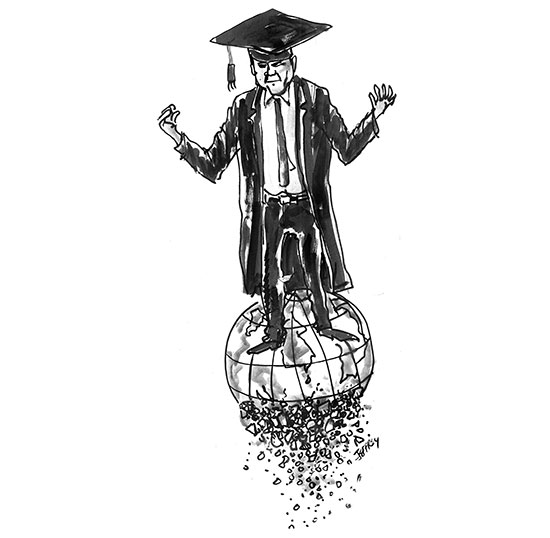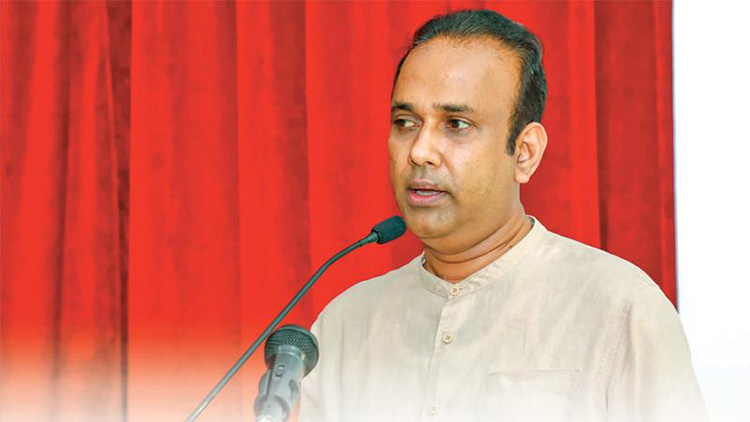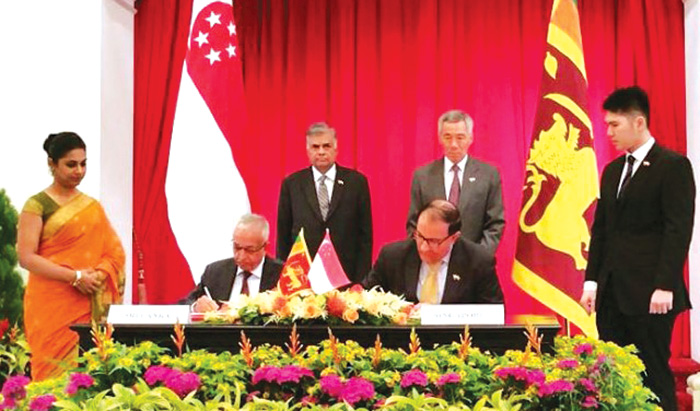Features
Education worthy of this moment of crisis

By Shamala Kumar
 I can’t remember the exact words, but remember the sentiment: Nobody is happy with our education, not one person. Education should be about imagining a better world, a country, and a future. Our education does none of that, it’s simply designed to perpetuate the system, blindly and uncritically.
I can’t remember the exact words, but remember the sentiment: Nobody is happy with our education, not one person. Education should be about imagining a better world, a country, and a future. Our education does none of that, it’s simply designed to perpetuate the system, blindly and uncritically.
The group, contributing to this column, the Kuppi Collective, was still forming, early into the Covid-19 lockdowns, when Anushka Kahandagama expressed thoughts such as these. In the months to follow, we tried to articulate what kind of education would foster such imaginations, thinking and doing.
The education system, to which we belonged, then and today, is not transformative, not in the way we envisioned. As far as education was concerned, the solution to the lockdown was to merely move from on-site to online, with little acknowledgement of the students who disappeared from our classrooms because of access issues, financial and mental health struggles. We continued, generally, to teach the same content, seemingly blind to the chaos that surrounded us. This suspension from reality, as if universities, our jobs, and education, operate in a vacuum, continues. Only last week, Sudesh Mantillake, another from the Kuppi Collective, stated in frustration, “We work as usual when around us the world disintegrates.”
Therefore, I reflect on this current moment, and how we seem to have lost touch, alienated from students, society, and even ourselves. I wonder what happened!
The university and the present moment
We, as a university community, were slow to situate ourselves in this present crisis. Recently, in my Department, we noted the lack of seminars and discussion, within the university. Somebody responded, “All we seem to do is administration; there’s no time to think”. We have become an institution of automatons and paper-pushers. Where are the topics that spark controversy, fuel debate and disagreement?
The day Sudesh spoke about his frustrations of going on as usual, I met our students as they seemed withdrawn and tired. They were working part-time to support their families, feared for the future and were grappling with the trauma of the past two years. One student said in anguish, “Madam, all of us are depressed”. Students had immediate and practical concerns. Food prices were rising daily and travelling home was expensive. They spent Rs. 600 a day for food, I learnt.
Our Faculty has been supporting students who needed help, but as problems compound and needs expand, we are at a loss. “How do we help them? We have no answers”, said the lead staff member responsible for student welfare. Yet we persist, teaching the same, researching the same, and demonstrating quality the same.
Quality as abstract
Perhaps the greatest transformation, happening at universities these days, is the quality assurance process. Practically all academic staff are busy collecting documents to show that we deliver quality. Quality is, of course, defined from above, at the University Grants Commission. Little discussion of what exactly we are doing in pursuing quality has occurred at my university. The quality assurance process construes the student and teacher as equally dispassionate. The teacher, a technically sound, professional, delivers carefully planned lessons designed to create “employable” “products” suited to the job market. Whether the student is indeed a product, what employable means in a non-existent job market, and whether our students could aspire to something else – such as changing the world – have never truly been discussed.
The system is static and sterile and all the planning, based on predetermined prototypes for “products” (the graduates), have made the system and us distant from the problems that surround us and that we confront in our own lives. Our teaching does not capture the charged experiences of our students, the country’s disarray, compounded by war and violence around the globe.
Similarly, in research undertaken at universities, “Quality” is judged by journal rankings. The more desired publications, the ones the system salivates over, are inaccessible to us as our libraries cannot afford them. Content these outlets deem hot and sexy, and worthy of publication, may do little to address our problems. The problems and content, such publications attract, are designed to respond to the needs of academics and publishing companies in distant lands, who control the academic publishing industry. Quality in research has removed us from this moment and the reality that is our crisis.
This, to me, is a significant part of the sluggishness with which universities have responded to our national problems. Another is likely to be our salaries that have cushioned the blow that has affected much of our population. My bigger point, however, is to highlight the reform process through which universities are trying to improve, that it does little to address the present needs of the nation.
An alternative in the making
I see within the ‘GotaGo’ protests an alternative forming. There’s a fluidity, an openness, a space for all within those places of protest, to speak and be heard. This is by contrast to universities, with their heavily guarded gates that let only the legitimate in, CCTV cameras, dress codes, and a hierarchy that stifles the other.
Of course, the seeming openness of the protests is limited. Some students tell me that critique of the IMF is out of bounds, although who makes these determinations is unclear. Symbols of patriotism, the national flag and the national anthem are very much a part of protests – symbols that for minorities can be intimidating and marginalizing.
I also worry that just as past governments have used these symbols of nationhood to consolidate power, and shy away from issues that truly reflect our human experiences, this time, too, they will be used to hide the problems of the economically, socially and politically marginalized; silenced for the good of the collective. We see this already. Concerns that are particularly of importance to minority communities, such as the removal of the PTA, acknowledgment of war-related disappearances, demilitarization, and issues of displacement, are shoved aside as divisive and secondary. Yet, the ‘GotaGo’ protest spaces offer a contrast to the universities in which we have no time to even think. It offers us new conceptions of free education, free universities, that can feed our process of reforming education.
The place for the Arts in Free education…
I see the Arts as central to such reforms. In this column, we have expressed concern over the systematic marginalization of Arts subjects, within our educational system. Policies underfund these subjects, treat them as cheap alternatives to the hard sciences and technologies. Yet, these are the very subjects that can harness our imagination, help us articulate the most profound of ideas, and potentially be transformational.
Last week, at the GotaGoGama, someone got on a stool and spoke. I took a good look at her; thinking I would see more of her in the future; I wanted to remember her face for when that happened. She drew a huge crowd through her impassioned speech. At one point she dismissed those who rejected the art, music, and drama at GotaGoGama as a carnival that diluted the cause. She named a series of artists, poets, authors, who changed the world. “Weren’t they revolutionaries?” she shouted, “Didn’t they spark revolutions? Didn’t they change the world?”. It is also the Arts that play centerstage in the GotaGoGama teach-ins. Strong Arts programmes can give us the language to envision and create the democratic and peaceful future that we all crave right now.
Grounding ourselves and opening spaces
I hope this moment transforms our universities and education system. I continue my work — teaching my predesigned classes, getting ready for quality assessments, working as usual. I worry about our students and the lack of funds to operate, and worry about my son, and shortages of cooking gas and food at home. Within this space, between normalcy and chaos, lies small opportunities to participate in this moment, whether simply participating as an individual, or as FUTA in protests, or in discussions. We are doing this now, in small ways.
My wish, however, is for something more for my university and work. I would like my teaching, research and everything I do at the university to reflect the reality of our country, to address the problems that we face as a society, particularly those on the margins. If we can transform our universities to have that organic quality, which conceives of “quality” as being immediately responsive to our problems, of being transgressive, as free education should be, and as very much a part of the moment, then as far as education is concerned, this moment will have had an unmeasurable effect on our collective future. We would then be teaching and researching in a way that moves with the people and the moment. How beautiful that would be…
(The author teaches at the University of Peradeniya)
Kuppi is a politics and pedagogy happening on the margins of the lecture hall that parodies, subverts, and simultaneously reaffirms social hierarchies.
Features
The heart-friendly health minister

by Dr Gotabhya Ranasinghe
Senior Consultant Cardiologist
National Hospital Sri Lanka
When we sought a meeting with Hon Dr. Ramesh Pathirana, Minister of Health, he graciously cleared his busy schedule to accommodate us. Renowned for his attentive listening and deep understanding, Minister Pathirana is dedicated to advancing the health sector. His openness and transparency exemplify the qualities of an exemplary politician and minister.
Dr. Palitha Mahipala, the current Health Secretary, demonstrates both commendable enthusiasm and unwavering support. This combination of attributes makes him a highly compatible colleague for the esteemed Minister of Health.
Our discussion centered on a project that has been in the works for the past 30 years, one that no other minister had managed to advance.
Minister Pathirana, however, recognized the project’s significance and its potential to revolutionize care for heart patients.
The project involves the construction of a state-of-the-art facility at the premises of the National Hospital Colombo. The project’s location within the premises of the National Hospital underscores its importance and relevance to the healthcare infrastructure of the nation.
This facility will include a cardiology building and a tertiary care center, equipped with the latest technology to handle and treat all types of heart-related conditions and surgeries.
Securing funding was a major milestone for this initiative. Minister Pathirana successfully obtained approval for a $40 billion loan from the Asian Development Bank. With the funding in place, the foundation stone is scheduled to be laid in September this year, and construction will begin in January 2025.
This project guarantees a consistent and uninterrupted supply of stents and related medications for heart patients. As a result, patients will have timely access to essential medical supplies during their treatment and recovery. By securing these critical resources, the project aims to enhance patient outcomes, minimize treatment delays, and maintain the highest standards of cardiac care.
Upon its fruition, this monumental building will serve as a beacon of hope and healing, symbolizing the unwavering dedication to improving patient outcomes and fostering a healthier society.We anticipate a future marked by significant progress and positive outcomes in Sri Lanka’s cardiovascular treatment landscape within the foreseeable timeframe.
Features
A LOVING TRIBUTE TO JESUIT FR. ALOYSIUS PIERIS ON HIS 90th BIRTHDAY

by Fr. Emmanuel Fernando, OMI
Jesuit Fr. Aloysius Pieris (affectionately called Fr. Aloy) celebrated his 90th birthday on April 9, 2024 and I, as the editor of our Oblate Journal, THE MISSIONARY OBLATE had gone to press by that time. Immediately I decided to publish an article, appreciating the untiring selfless services he continues to offer for inter-Faith dialogue, the renewal of the Catholic Church, his concern for the poor and the suffering Sri Lankan masses and to me, the present writer.
It was in 1988, when I was appointed Director of the Oblate Scholastics at Ampitiya by the then Oblate Provincial Fr. Anselm Silva, that I came to know Fr. Aloy more closely. Knowing well his expertise in matters spiritual, theological, Indological and pastoral, and with the collaborative spirit of my companion-formators, our Oblate Scholastics were sent to Tulana, the Research and Encounter Centre, Kelaniya, of which he is the Founder-Director, for ‘exposure-programmes’ on matters spiritual, biblical, theological and pastoral. Some of these dimensions according to my view and that of my companion-formators, were not available at the National Seminary, Ampitiya.
Ever since that time, our Oblate formators/ accompaniers at the Oblate Scholasticate, Ampitiya , have continued to send our Oblate Scholastics to Tulana Centre for deepening their insights and convictions regarding matters needed to serve the people in today’s context. Fr. Aloy also had tried very enthusiastically with the Oblate team headed by Frs. Oswald Firth and Clement Waidyasekara to begin a Theologate, directed by the Religious Congregations in Sri Lanka, for the contextual formation/ accompaniment of their members. It should very well be a desired goal of the Leaders / Provincials of the Religious Congregations.
Besides being a formator/accompanier at the Oblate Scholasticate, I was entrusted also with the task of editing and publishing our Oblate journal, ‘The Missionary Oblate’. To maintain the quality of the journal I continue to depend on Fr. Aloy for his thought-provoking and stimulating articles on Biblical Spirituality, Biblical Theology and Ecclesiology. I am very grateful to him for his generous assistance. Of late, his writings on renewal of the Church, initiated by Pope St. John XX111 and continued by Pope Francis through the Synodal path, published in our Oblate journal, enable our readers to focus their attention also on the needed renewal in the Catholic Church in Sri Lanka. Fr. Aloy appreciated very much the Synodal path adopted by the Jesuit Pope Francis for the renewal of the Church, rooted very much on prayerful discernment. In my Religious and presbyteral life, Fr.Aloy continues to be my spiritual animator / guide and ongoing formator / acccompanier.
Fr. Aloysius Pieris, BA Hons (Lond), LPh (SHC, India), STL (PFT, Naples), PhD (SLU/VC), ThD (Tilburg), D.Ltt (KU), has been one of the eminent Asian theologians well recognized internationally and one who has lectured and held visiting chairs in many universities both in the West and in the East. Many members of Religious Congregations from Asian countries have benefited from his lectures and guidance in the East Asian Pastoral Institute (EAPI) in Manila, Philippines. He had been a Theologian consulted by the Federation of Asian Bishops’ Conferences for many years. During his professorship at the Gregorian University in Rome, he was called to be a member of a special group of advisers on other religions consulted by Pope Paul VI.
Fr. Aloy is the author of more than 30 books and well over 500 Research Papers. Some of his books and articles have been translated and published in several countries. Among those books, one can find the following: 1) The Genesis of an Asian Theology of Liberation (An Autobiographical Excursus on the Art of Theologising in Asia, 2) An Asian Theology of Liberation, 3) Providential Timeliness of Vatican 11 (a long-overdue halt to a scandalous millennium, 4) Give Vatican 11 a chance, 5) Leadership in the Church, 6) Relishing our faith in working for justice (Themes for study and discussion), 7) A Message meant mainly, not exclusively for Jesuits (Background information necessary for helping Francis renew the Church), 8) Lent in Lanka (Reflections and Resolutions, 9) Love meets wisdom (A Christian Experience of Buddhism, 10) Fire and Water 11) God’s Reign for God’s poor, 12) Our Unhiddden Agenda (How we Jesuits work, pray and form our men). He is also the Editor of two journals, Vagdevi, Journal of Religious Reflection and Dialogue, New Series.
Fr. Aloy has a BA in Pali and Sanskrit from the University of London and a Ph.D in Buddhist Philosophy from the University of Sri Lankan, Vidyodaya Campus. On Nov. 23, 2019, he was awarded the prestigious honorary Doctorate of Literature (D.Litt) by the Chancellor of the University of Kelaniya, the Most Venerable Welamitiyawe Dharmakirthi Sri Kusala Dhamma Thera.
Fr. Aloy continues to be a promoter of Gospel values and virtues. Justice as a constitutive dimension of love and social concern for the downtrodden masses are very much noted in his life and work. He had very much appreciated the commitment of the late Fr. Joseph (Joe) Fernando, the National Director of the Social and Economic Centre (SEDEC) for the poor.
In Sri Lanka, a few religious Congregations – the Good Shepherd Sisters, the Christian Brothers, the Marist Brothers and the Oblates – have invited him to animate their members especially during their Provincial Congresses, Chapters and International Conferences. The mainline Christian Churches also have sought his advice and followed his seminars. I, for one, regret very much, that the Sri Lankan authorities of the Catholic Church –today’s Hierarchy—- have not sought Fr.
Aloy’s expertise for the renewal of the Catholic Church in Sri Lanka and thus have not benefited from the immense store of wisdom and insight that he can offer to our local Church while the Sri Lankan bishops who governed the Catholic church in the immediate aftermath of the Second Vatican Council (Edmund Fernando OMI, Anthony de Saram, Leo Nanayakkara OSB, Frank Marcus Fernando, Paul Perera,) visited him and consulted him on many matters. Among the Tamil Bishops, Bishop Rayappu Joseph was keeping close contact with him and Bishop J. Deogupillai hosted him and his team visiting him after the horrible Black July massacre of Tamils.
Features
A fairy tale, success or debacle

Sri Lanka-Singapore Free Trade Agreement
By Gomi Senadhira
senadhiragomi@gmail.com
“You might tell fairy tales, but the progress of a country cannot be achieved through such narratives. A country cannot be developed by making false promises. The country moved backward because of the electoral promises made by political parties throughout time. We have witnessed that the ultimate result of this is the country becoming bankrupt. Unfortunately, many segments of the population have not come to realize this yet.” – President Ranil Wickremesinghe, 2024 Budget speech
Any Sri Lankan would agree with the above words of President Wickremesinghe on the false promises our politicians and officials make and the fairy tales they narrate which bankrupted this country. So, to understand this, let’s look at one such fairy tale with lots of false promises; Ranil Wickremesinghe’s greatest achievement in the area of international trade and investment promotion during the Yahapalana period, Sri Lanka-Singapore Free Trade Agreement (SLSFTA).
It is appropriate and timely to do it now as Finance Minister Wickremesinghe has just presented to parliament a bill on the National Policy on Economic Transformation which includes the establishment of an Office for International Trade and the Sri Lanka Institute of Economics and International Trade.
Was SLSFTA a “Cleverly negotiated Free Trade Agreement” as stated by the (former) Minister of Development Strategies and International Trade Malik Samarawickrama during the Parliamentary Debate on the SLSFTA in July 2018, or a colossal blunder covered up with lies, false promises, and fairy tales? After SLSFTA was signed there were a number of fairy tales published on this agreement by the Ministry of Development Strategies and International, Institute of Policy Studies, and others.
However, for this article, I would like to limit my comments to the speech by Minister Samarawickrama during the Parliamentary Debate, and the two most important areas in the agreement which were covered up with lies, fairy tales, and false promises, namely: revenue loss for Sri Lanka and Investment from Singapore. On the other important area, “Waste products dumping” I do not want to comment here as I have written extensively on the issue.
1. The revenue loss
During the Parliamentary Debate in July 2018, Minister Samarawickrama stated “…. let me reiterate that this FTA with Singapore has been very cleverly negotiated by us…. The liberalisation programme under this FTA has been carefully designed to have the least impact on domestic industry and revenue collection. We have included all revenue sensitive items in the negative list of items which will not be subject to removal of tariff. Therefore, 97.8% revenue from Customs duty is protected. Our tariff liberalisation will take place over a period of 12-15 years! In fact, the revenue earned through tariffs on goods imported from Singapore last year was Rs. 35 billion.
The revenue loss for over the next 15 years due to the FTA is only Rs. 733 million– which when annualised, on average, is just Rs. 51 million. That is just 0.14% per year! So anyone who claims the Singapore FTA causes revenue loss to the Government cannot do basic arithmetic! Mr. Speaker, in conclusion, I call on my fellow members of this House – don’t mislead the public with baseless criticism that is not grounded in facts. Don’t look at petty politics and use these issues for your own political survival.”
I was surprised to read the minister’s speech because an article published in January 2018 in “The Straits Times“, based on information released by the Singaporean Negotiators stated, “…. With the FTA, tariff savings for Singapore exports are estimated to hit $10 million annually“.
As the annual tariff savings (that is the revenue loss for Sri Lanka) calculated by the Singaporean Negotiators, Singaporean $ 10 million (Sri Lankan rupees 1,200 million in 2018) was way above the rupees’ 733 million revenue loss for 15 years estimated by the Sri Lankan negotiators, it was clear to any observer that one of the parties to the agreement had not done the basic arithmetic!
Six years later, according to a report published by “The Morning” newspaper, speaking at the Committee on Public Finance (COPF) on 7th May 2024, Mr Samarawickrama’s chief trade negotiator K.J. Weerasinghehad had admitted “…. that forecasted revenue loss for the Government of Sri Lanka through the Singapore FTA is Rs. 450 million in 2023 and Rs. 1.3 billion in 2024.”
If these numbers are correct, as tariff liberalisation under the SLSFTA has just started, we will pass Rs 2 billion very soon. Then, the question is how Sri Lanka’s trade negotiators made such a colossal blunder. Didn’t they do their basic arithmetic? If they didn’t know how to do basic arithmetic they should have at least done their basic readings. For example, the headline of the article published in The Straits Times in January 2018 was “Singapore, Sri Lanka sign FTA, annual savings of $10m expected”.
Anyway, as Sri Lanka’s chief negotiator reiterated at the COPF meeting that “…. since 99% of the tariffs in Singapore have zero rates of duty, Sri Lanka has agreed on 80% tariff liberalisation over a period of 15 years while expecting Singapore investments to address the imbalance in trade,” let’s turn towards investment.
Investment from Singapore
In July 2018, speaking during the Parliamentary Debate on the FTA this is what Minister Malik Samarawickrama stated on investment from Singapore, “Already, thanks to this FTA, in just the past two-and-a-half months since the agreement came into effect we have received a proposal from Singapore for investment amounting to $ 14.8 billion in an oil refinery for export of petroleum products. In addition, we have proposals for a steel manufacturing plant for exports ($ 1 billion investment), flour milling plant ($ 50 million), sugar refinery ($ 200 million). This adds up to more than $ 16.05 billion in the pipeline on these projects alone.
And all of these projects will create thousands of more jobs for our people. In principle approval has already been granted by the BOI and the investors are awaiting the release of land the environmental approvals to commence the project.
I request the Opposition and those with vested interests to change their narrow-minded thinking and join us to develop our country. We must always look at what is best for the whole community, not just the few who may oppose. We owe it to our people to courageously take decisions that will change their lives for the better.”
According to the media report I quoted earlier, speaking at the Committee on Public Finance (COPF) Chief Negotiator Weerasinghe has admitted that Sri Lanka was not happy with overall Singapore investments that have come in the past few years in return for the trade liberalisation under the Singapore-Sri Lanka Free Trade Agreement. He has added that between 2021 and 2023 the total investment from Singapore had been around $162 million!
What happened to those projects worth $16 billion negotiated, thanks to the SLSFTA, in just the two-and-a-half months after the agreement came into effect and approved by the BOI? I do not know about the steel manufacturing plant for exports ($ 1 billion investment), flour milling plant ($ 50 million) and sugar refinery ($ 200 million).
However, story of the multibillion-dollar investment in the Petroleum Refinery unfolded in a manner that would qualify it as the best fairy tale with false promises presented by our politicians and the officials, prior to 2019 elections.
Though many Sri Lankans got to know, through the media which repeatedly highlighted a plethora of issues surrounding the project and the questionable credentials of the Singaporean investor, the construction work on the Mirrijiwela Oil Refinery along with the cement factory began on the24th of March 2019 with a bang and Minister Ranil Wickremesinghe and his ministers along with the foreign and local dignitaries laid the foundation stones.
That was few months before the 2019 Presidential elections. Inaugurating the construction work Prime Minister Ranil Wickremesinghe said the projects will create thousands of job opportunities in the area and surrounding districts.
The oil refinery, which was to be built over 200 acres of land, with the capacity to refine 200,000 barrels of crude oil per day, was to generate US$7 billion of exports and create 1,500 direct and 3,000 indirect jobs. The construction of the refinery was to be completed in 44 months. Four years later, in August 2023 the Cabinet of Ministers approved the proposal presented by President Ranil Wickremesinghe to cancel the agreement with the investors of the refinery as the project has not been implemented! Can they explain to the country how much money was wasted to produce that fairy tale?
It is obvious that the President, ministers, and officials had made huge blunders and had deliberately misled the public and the parliament on the revenue loss and potential investment from SLSFTA with fairy tales and false promises.
As the president himself said, a country cannot be developed by making false promises or with fairy tales and these false promises and fairy tales had bankrupted the country. “Unfortunately, many segments of the population have not come to realize this yet”.
(The writer, a specialist and an activist on trade and development issues . )












